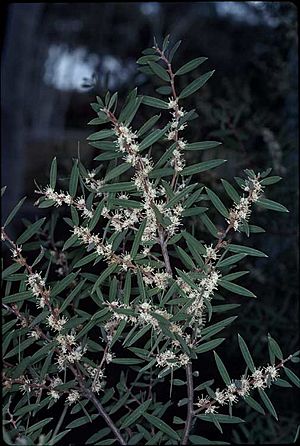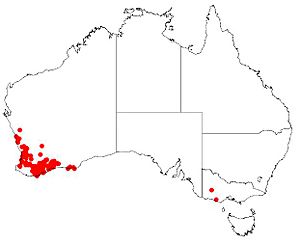Hakea marginata facts for kids
Quick facts for kids Hakea marginata |
|
|---|---|
 |
|
| Hakea marginata in the ANBG | |
| Scientific classification | |
| Genus: |
Hakea
|
| Species: |
marginata
|
 |
|
| Occurrence data from AVH | |
The Hakea marginata is a type of shrub that belongs to the plant family called Proteaceae. This plant is special because it grows only in certain parts of Western Australia. You can find it in the Mid West, Wheatbelt, Peel, South West, Great Southern and Goldfields-Esperance regions.
What it Looks Like
Hakea marginata is a shrub that usually grows upright and can be rounded or spread out. It typically reaches a height of about 1 to 5 meters (3 to 16 feet). This plant does not have a special woody swelling at its base that helps it regrow after fire.
It blooms from August to October, showing off sweet-smelling white or creamy yellow flowers. These flowers grow in small groups where the leaves meet the stems, usually on the upper branches.
The leaves of Hakea marginata are stiff and flat. They are long and thin, about 2-5 centimeters (0.8-2 inches) long and 0.4-1 centimeter (0.16-0.4 inches) wide. Each leaf ends in a sharp point. A cool feature of these leaves is their bright yellow veins, both along the edges and in the middle.
How it Got its Name
This plant was first officially described in 1810 by a Scottish botanist named Robert Brown (botanist, born 1773). His description was published in a scientific journal called Transactions of the Linnean Society of London.
The name marginata comes from the Latin word marginatus, which means "with a border". This name refers to the clear border or margin you can see around the edges of the plant's leaves.
Where it Grows
Hakea marginata is found widely across Western Australia. Its range stretches from Jurien Bay in the west, all the way to Kalgoorlie and Cape Arid National Park in the east.
It likes to grow in sandy or clay soils, often mixed with gravel. You can find it in open woodlands or areas with low shrubs, especially along road edges, in waterways, and in creek gullies. Sometimes, these plants grow so close together they form dense bushes. These thickets are great hiding spots and homes for local wildlife.
Conservation Status
The good news is that the Western Australian Government considers Hakea marginata to be "not threatened". This means it is not currently at risk of disappearing.

